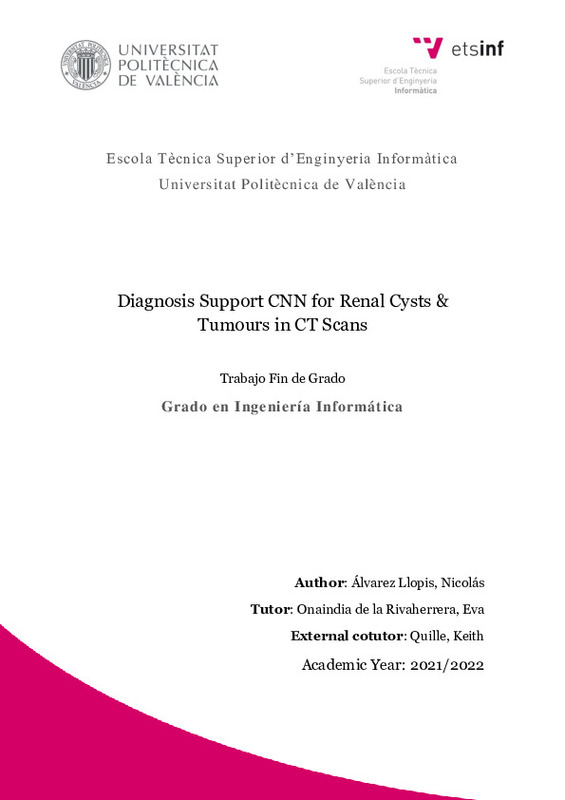JavaScript is disabled for your browser. Some features of this site may not work without it.
Buscar en RiuNet
Listar
Mi cuenta
Estadísticas
Ayuda RiuNet
Admin. UPV
Diagnosis Support CNN for Renal Cysts & Tumours in CT Scans
Mostrar el registro sencillo del ítem
Ficheros en el ítem
| dc.contributor.advisor | Onaindia de la Rivaherrera, Eva
|
es_ES |
| dc.contributor.advisor | Quille, Keith
|
es_ES |
| dc.contributor.author | Álvarez Llopis, Nicolás
|
es_ES |
| dc.date.accessioned | 2022-10-13T09:10:52Z | |
| dc.date.available | 2022-10-13T09:10:52Z | |
| dc.date.created | 2022-09-21 | |
| dc.date.issued | 2022-10-13 | es_ES |
| dc.identifier.uri | http://hdl.handle.net/10251/187581 | |
| dc.description.abstract | [EN] Cancerous carcinomas are the most common kidney tumours, accounting for more than 90% of clinical cases. Studies show that more and more cases are being diagnosed with cancerous masses, with more than 400,000 new cases reported worldwide in 2020. The difficulty of diagnosis between renal tumours and renal cysts implies the need to develop an accurate diagnostic system. This paper proposes a CNN model for detecting pathological kidneys containing cysts or cancers. Several topologies were studied, focusing mainly on the comparison of the models versus their size, selecting the large one as the best of them. The model, trained and validated with a 66% - 33% percentage split, is able to classify tumours, cysts and healthy kidneys with 99.91% accuracy. When tested on clinical cases, the model obtains a maximum accuracy of 31.58%. The study conducted to justify such variation in performance indicates that the training images are not representative of the real cases. Either because of the alterations they may have undergone or because of the specific characteristics they follow, the model is limited and conditioned by the images it can classify. | es_ES |
| dc.description.abstract | [ES] Este trabajo propone un modelo de CNN para la detección de riñones patológicos que contienen quistes o cánceres. Se recorre todo el proceso de creación del mismo, estudiando el mejor rendimiento posible, y se analizan los resultados obtenidos en relación con el trasfondo ético que lo sustenta. | es_ES |
| dc.format.extent | 50 | es_ES |
| dc.language | Inglés | es_ES |
| dc.publisher | Universitat Politècnica de València | es_ES |
| dc.rights | Reserva de todos los derechos | es_ES |
| dc.subject | Convolutional | es_ES |
| dc.subject | Neural | es_ES |
| dc.subject | Network | es_ES |
| dc.subject | Deep | es_ES |
| dc.subject | Learning | es_ES |
| dc.subject | Cyst | es_ES |
| dc.subject | Cancer | es_ES |
| dc.subject | Kidney | es_ES |
| dc.subject | CT | es_ES |
| dc.subject | CNN | es_ES |
| dc.subject | Red | es_ES |
| dc.subject | Neuronal | es_ES |
| dc.subject | Convolucional | es_ES |
| dc.subject | Aprendizaje profundo | es_ES |
| dc.subject | Quiste | es_ES |
| dc.subject | Cáncer | es_ES |
| dc.subject | Riñón | es_ES |
| dc.subject.classification | LENGUAJES Y SISTEMAS INFORMATICOS | es_ES |
| dc.subject.other | Grado en Ingeniería Informática-Grau en Enginyeria Informàtica | es_ES |
| dc.title | Diagnosis Support CNN for Renal Cysts & Tumours in CT Scans | es_ES |
| dc.title.alternative | CNN de Apoyo al Diagnóstico de Tumores y Quistes Renales en Escáneres CT | es_ES |
| dc.title.alternative | CNN de Suport al Diagnòstic de Tumors i Quistos Renals en Escàners CT | es_ES |
| dc.type | Proyecto/Trabajo fin de carrera/grado | es_ES |
| dc.rights.accessRights | Abierto | es_ES |
| dc.contributor.affiliation | Universitat Politècnica de València. Departamento de Sistemas Informáticos y Computación - Departament de Sistemes Informàtics i Computació | es_ES |
| dc.contributor.affiliation | Universitat Politècnica de València. Escola Tècnica Superior d'Enginyeria Informàtica | es_ES |
| dc.description.bibliographicCitation | Álvarez Llopis, N. (2022). Diagnosis Support CNN for Renal Cysts & Tumours in CT Scans. Universitat Politècnica de València. http://hdl.handle.net/10251/187581 | es_ES |
| dc.description.accrualMethod | TFGM | es_ES |
| dc.relation.pasarela | TFGM\149787 | es_ES |
Este ítem aparece en la(s) siguiente(s) colección(ones)
-
ETSINF - Trabajos académicos [5160]
Escola Tècnica Superior d'Enginyeria Informàtica






